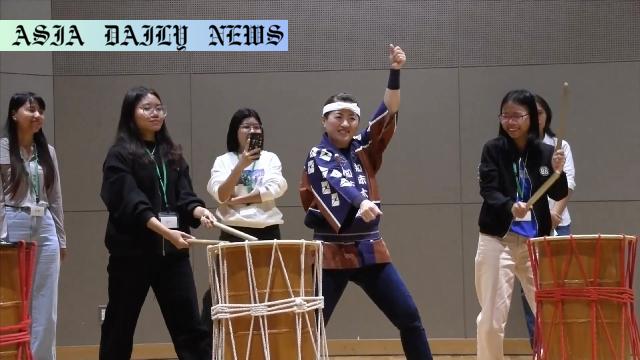Taiko Drumming: Students from abroad experienced Japanese taiko drumming to deepen their understanding of the country’s culture.
Taiko drumming event in Hokkaido hosted for cultural immersion.
Foreign students learned basic drum techniques and rhythms.
Participants found the experience enjoyable and meaningful.

Introduction
Japanese culture is renowned for its rich history, traditions, and arts, one of which is taiko drumming. In a small town in Hokkaido, foreign students were offered a unique opportunity to connect deeply with this traditional art form. Organized by a Japanese-language school in Nakashibetsu, this initiative aimed at fostering cultural understanding and appreciation among international participants. With 50 students attending, the event became a mesmerizing blend of powerful performances and hands-on experience.
The Power and Legacy of Taiko Drumming
Taiko, which translates to ‘drum’ in Japanese, has been a significant part of Japan’s cultural tapestry for centuries. Historically, these drums were used in festivals, religious ceremonies, and even on battlefields to communicate commands. The rhythmic sounds convey a deep sense of energy, unity, and emotion. For the students in Nakashibetsu, listening to the dynamic performance from the local taiko group offered an enthralling introduction to this beautiful art.
Performing a piece inspired by the sea and Hokkaido’s fishing culture, the taiko drummers unleashed their mastery, captivating the audience. The performance demonstrated not only technical precision but also the story-telling aspect of taiko, making it a perfect medium for cultural exchange. Students’ awe at the performance highlighted the universal language of music and rhythm.
Experiencing Taiko First-Hand
Following the captivating performance, it was time for the students to try their hands at taiko drumming. Guided by experts, they began by learning the basics, including the proper stance and striking technique. Standing with left legs positioned diagonally forward and knees slightly bent, the students practiced lifting their drumsticks and striking the drum’s center. The instructors emphasized the importance of precision and rhythm in creating harmonious sounds.
The hands-on experience not only taught technical skills but also revealed how physical and mental harmony is vital to perfecting the art of taiko. Students were encouraged to either follow a rhythm or improvise, allowing them to express themselves freely while feeling the resonance of each drumbeat.
Personal Experiences and Reactions
The event’s impact was clearly visible in the responses of the participants. A student from Nepal shared how challenging yet enjoyable the experience was. Another individual from Myanmar confessed to initially feeling nervous but expressed enthusiasm about giving taiko drumming another try in the future. These responses reflect the power of interactive cultural activities in creating a lasting emotional connection with traditions.
Such experiences do more than familiarize participants with a culture. They allow them to build memories, form relationships, and develop a deeper appreciation for the traditions of their host country. Taiko drumming became more than just a musical performance; it became a bridge that united diverse cultural backgrounds and perspectives.
The Broader Significance of Cultural Exchange
In today’s increasingly globalized world, cultural exchange programs play a crucial role in breaking down barriers and fostering mutual understanding. The taiko drumming event in Nakashibetsu serves as an excellent example of how music and art can bridge cultural gaps. Events like this not only help international students integrate into their host community but also make them cultural ambassadors when they share these experiences back home.
Furthermore, such initiatives support local arts and artists in preserving traditions. By exposing new audiences to practices like taiko drumming, the event ensures that these age-old art forms continue to thrive in modern times. It’s a win-win situation—both for the participants and the local artisans who keep these traditions alive.
Conclusion
The taiko drumming event in Hokkaido was more than just a lesson in music; it was an immersive cultural experience that left both students and performers enriched. The overwhelming response from participants underscores the importance of creating spaces where cultures can meet, interact, and celebrate their uniqueness. By bringing Japan’s traditional art forms closer to the global audience, such initiatives lay the foundation for a more inclusive and interconnected world.
Commentary
Taiko Drumming As a Tool for Connection
The taiko drumming event held in Nakashibetsu highlights the universal power of art and culture in uniting people from diverse backgrounds. Such initiatives remind us of how traditional practices carry an intrinsic appeal that transcends language and borders. It’s fascinating to think that the very same rhythmic beats that once played a role in ancient Japanese ceremonies now serve as a bridge for cultural understanding in modern times.
Learning Beyond Language
For the participating students, the opportunity to experience taiko drumming offered far more than a fun activity—it provided a deeper insight into the cultural soul of Japan. The techniques they learned, however basic, demanded focus, coordination, and respect for the art. These qualities, in turn, reflect some of the foundational values in Japanese society. Such an immersive approach to cultural education is bound to create a stronger connection to the host country than traditional classroom lessons ever could.
The Need for More Cultural Exchange Programs
The event also underscores the importance of institutions supporting cultural exchange programs. For the students, these opportunities open doors to experiences that are often transformative, both personally and educationally. At the same time, it is encouraging to see local communities, like the taiko group in Nakashibetsu, actively participating in such events. This reciprocal exchange fosters a spirit of openness and curiosity, essential traits in today’s interconnected world.
Overall, the event in Nakashibetsu stands as a testament to the unifying power of culture. Similar initiatives globally could sow seeds of understanding and appreciation among people, one rhythmic drumbeat at a time.


